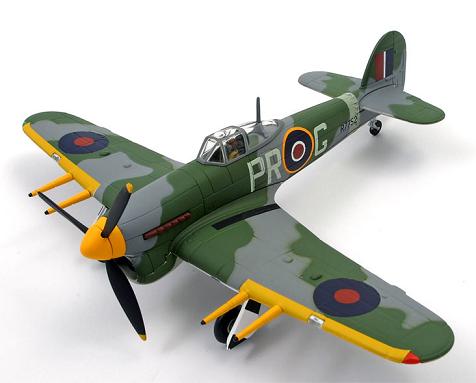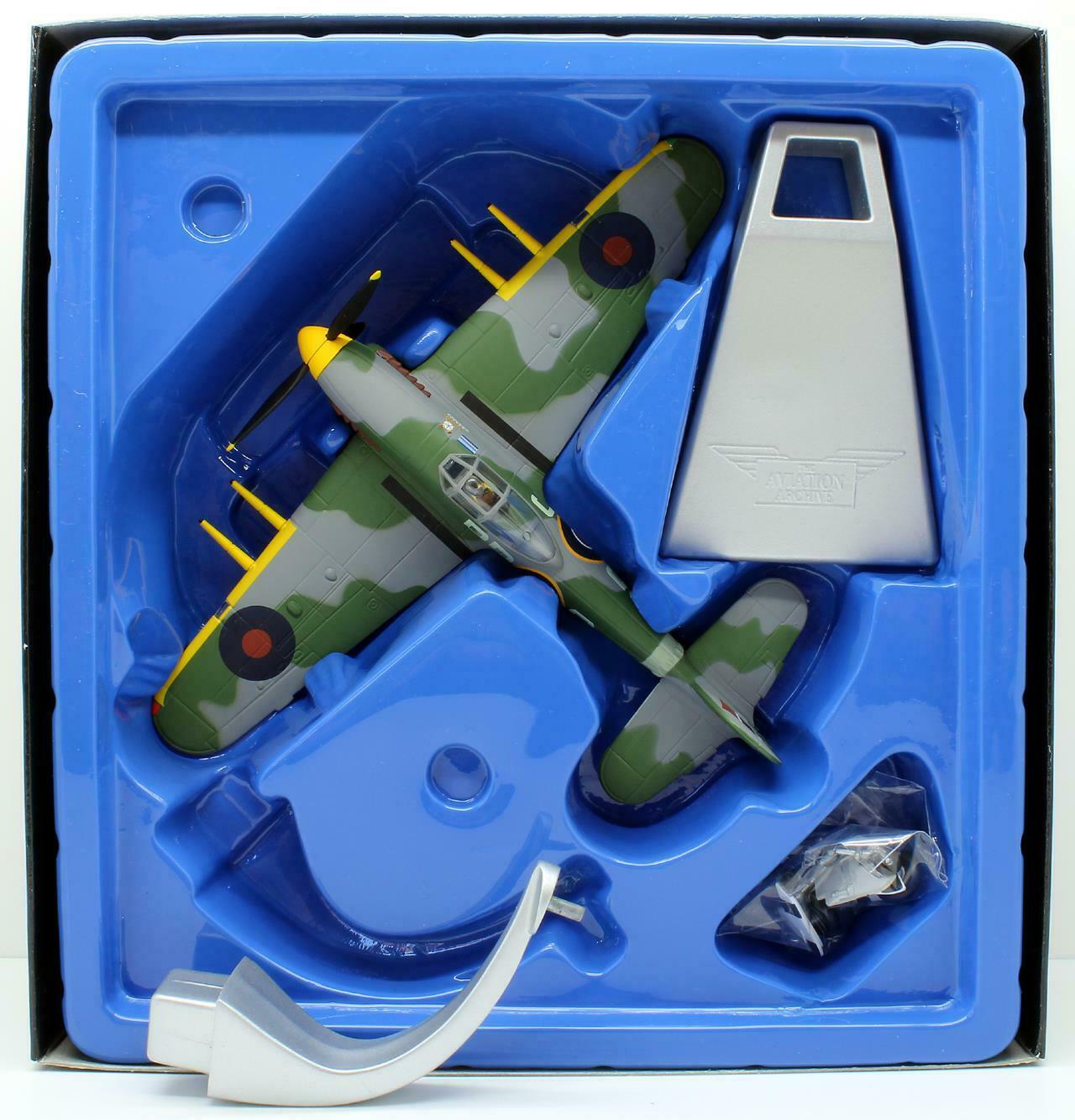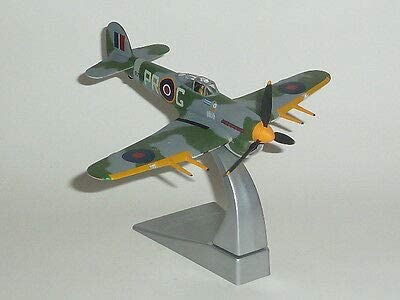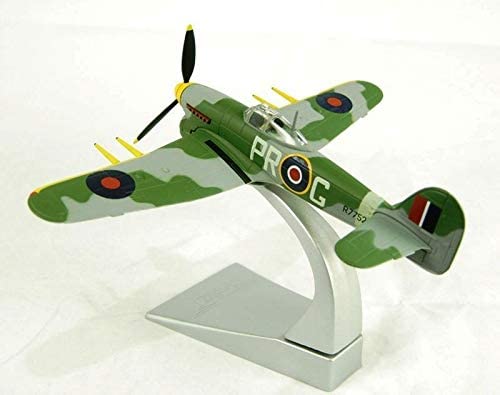Hawker Typhoon Mk1B – 609 Sqn RAF, Roland Beamont, Manston February 1943
Typhoon Mk1B – 609 Sqn RAF, Roland Beamont.
2 in stock
£39.99
2 in stock
Corgi Aviation Archive 1/72 scale AA36502: Hawker Typhoon 1B of 609 squadron RAF, Sqn Ldr Roland “Bee” Beamont based at RAF Manston in February 1943. Mint and boxed limited edition of 4,270 pieces.
Length 5.25 inches Wingspan 7 inches
Beamont’s operational career began in 1939, flying Hawker Hurricanes with No. 87 Squadron RAF stationed at Lille in France with the air contingent of the British Expeditionary Force, scoring 3 ‘kills’ against German aircraft. With the withdrawal of British forces from the continent following the fall of France he took part in the Battle of Britain, claiming 3 more ‘kills’, after which he was involved with nightfighting trials with the Hurricane. He was awarded a Distinguished Flying Cross in June 1941, and was posted to No. 79 Squadron RAF, although he was court-martialled for transporting a WAAF to a dance at another RAF station in his single-seat Hurricane, and was severely admonished.
In December 1941 he was attached to Hawker’s at Langley as a Production and Experimental Test Pilot. In July 1942 he was back on operational flying, joining No. 609 Squadron RAF flying Hawker Typhoons and subsequently promoted to Squadron Commander. As Commanding Officer of one of the first Squadrons to operate the new and technically troublesome Typhoon, Beamont was instrumental in arguing for keeping the aircraft in RAF service against increasing establishment resistance while he assisted Hawker’s in resolving the type’s airframe and engine problems. His confidence in the Typhoon was vindicated as the aircraft eventually became the RAF’s most successful ground-attack aircraft during 1944-5.
In 1943 he returned to Hawker’s as a test pilot, performing experimental testing of the Hawker Tempest alongside the Hawker’s test pilot, Bill Humble. In 1944, prior to D-Day, he again resumed operational flying, this time forming the first Tempest Wing (No. 150) with the rank of Acting-Wing Commander, the Wing accounting for three Me 109s over the invasion beaches shortly after D-Day without loss, two credited to Beamont. At this time the Wing were switched to intercepting V-1s over Kent, shooting down 638, Beamont accounting for 32 of the unpiloted-flying bombs himself. On October 2, 1944, now based on the continent at Volkel, Holland, he achieved his ninth and final kill of the war when he shot down a Fw 190 near Nijmegen. On October 12, while attacking a heavily defended troop-train near Bocholt on his 492nd operational mission he was shot down, becoming a Prisoner of War. Confined firstly to Stalag-III at Sagan, near Breslau, then to Stalag III-A at Luckenwalde, near Potsdam, he remained a PoW until the end of the war in Europe, being finally repatriated in late May 1945 after being further detained with the other former POWs by the Russians.
With the end of hostilities his planned transfer to the Far East in command of a Wing of Tempest IIs was cancelled and he applied for a permanent commission. The eventual offer of a permanent commission coincided with his being offered a position as a test pilot; he resumed his career as a test pilot, performing the initial test flying of many notable aircraft including the Canberra and Lightning as well as the later-cancelled BAC TSR-2. In 1948, while visiting the US to fly the North American B-45 Tornado bomber, he was able to persuade the US authorities to give him permission to fly one of the only two XP-86 Sabres then built, based at Muroc Field. Briefed by test pilot George Welch, Beamont flew the XP-86 in May of that year, breaking the sound barrier (exceeding Mach 1) on his one and only flight in the aircraft, the third person to do so in the XP-86. He subsequently went on to become a director of the Warton division of BAC, later BAe, as a Director of Flight Operations. From 1970 he was responsible for the international testing of the Tornado MRCA. In 1979 he retired, devoting himself to writing and contributing to various aeronautical publications. He died on 19 November 2001 at the age of 81.
Beamont has the distinction of being the first pilot to make a double-atlantic crossing by jet, when on 26 August 1952, flying Canberra B.5 VX185, he flew from Aldergrove to Gander and then back again to Aldergove, in 10 hours 3 minutes. In 2002 was posthumously awarded the Belgian Croix de guerre.
The Hawker Typhoon was a British single-seat fighter-bomber, produced by Hawker Aircraft. While the Typhoon was designed to be a medium-high altitude interceptor, and a direct replacement for the Hawker Hurricane, several design problems were encountered, and the Typhoon never completely satisfied this requirement. Other external events in 1940 prolonged the gestation of the Typhoon.
Nicknamed the Tiffy in RAF slang, the Typhoon’s service introduction in mid-1941 was also plagued with problems, and for several months the aircraft faced a doubtful future. However, in 1941 the Luftwaffe brought the formidable Focke-Wulf Fw 190 into service: the Typhoon was the only fighter in the RAF inventory capable of catching the Fw 190 at low altitudes and, as a result, secured a new role as a low-altitude interceptor. Through the support of pilots such as Roland Beamont the Typhoon also established itself in roles such as night-time intruder and a long-range fighter. From late 1942 the Typhoon was equipped with bombs; from late 1943 ground attack rockets were added to the Typhoon’s armoury. Using these two weapons, the Typhoon became one of the Second World War’s most successful ground-attack aircraft.
| Weight | 0.8 kg |
|---|---|
| LIMITED EDITION | 4,270 |






